Primer: AFV Protection
- Jon Hawkes

- May 1, 2022
- 15 min read
Protection, or survivability as it tends to be called, is one of the three pillars of AFV capability that we all like to talk about (the others being firepower and mobility). But what is AFV protection, and why is it important to see it as more than just armour? This is purely an introductory post on the basic concept of survivability, there are a range of more specific primers that I have written and have in the pipeline.

A quick preface that this primer refers to a few technologies that will be added to the blog as their own primers in time, including things like active protection systems, passive and reactive armour, spall liners and fire suppression systems. I'll edit the post to add links to them as they are posted.
The survivability onion.
Protection is much more than simply resisting an attempt by a threat projectile to penetrate into the inside of a vehicle. To try and visualise the more holistic nature of protection, the concept of the 'survivability onion' is commonly used. You are at the core of the onion, hoping not to be killed, and around you are conceptual sequential layers of protection that are at increasing physical distance from you.

There is no single 'right' version of the onion and the terminology can vary, but the broad strokes of it are shown in the graphic above. Conceptually, they start at a very broad notion of protection by absence of presence, and end with very kinetic damage mitigation and management in the event of a penetration into the vehicle. Starting from the outermost layer:
Don't be there.
The first layer is a more recent addition to the onion and is commonly referred to as don’t be there. The best way to protect a vehicle from being killed is for it to not be in a position to possibly be killed in the first place. This means your force’s strategic planning and its Intelligence, Surveillance, Target Acquisition and Reconnaissance (ISTAR) capabilities are such that your vehicle was never required to be in a position to meet an enemy on unfavourable terms.

Increasingly this layer also refers to the continued development and proliferation of unmanned systems in the ground and air domains. A human and the vehicle they are in can be replaced, potentially, by one or more unmanned remote control or semi/fully autonomous ground platforms. The risks and layers of the survivability onion apply as much to unmanned platforms as much as any manned system, but removing the human occupied platform from the situation certainly solves the need to protect the occupants at a fundamental level.
Don't be seen.
The next layer is don’t be seen, sometimes referred to as don’t be detected. This reflects the art of camouflage and concealment across all spectrums. Most obviously and simply it is the camouflage of the vehicle and its occupants in the visible light spectrum – camouflage nets, local foliage, coatings and design features intended to limit the presented profile.

In addition, the fundamental design and shape of the vehicle has a significant impact - lower and smaller vehicles are inherently easier to disguise and find concealed positions to operate from than a larger and taller equivalent.
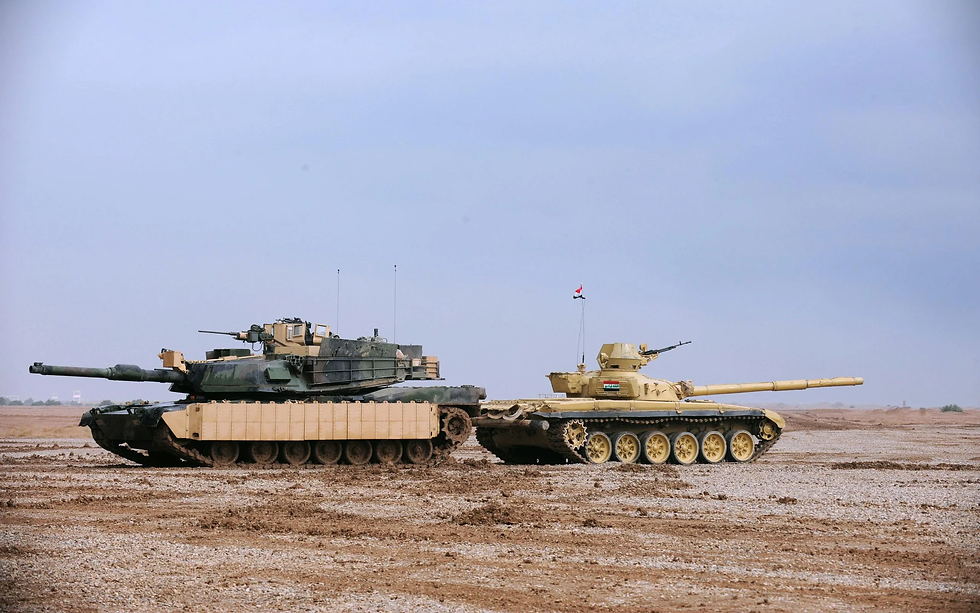
Beyond the visible spectrum, there are a myriad of further considerations. The thermal signature of an AFV can be significant, and with advanced thermal imaging optics widely utilised down to individual weapons, the need to mask thermal signatures is critical.
The underlying design of the vehicle should seek to mask thermal signatures wherever possible, for example the Leopard 2 tank is designed such that its engine, which produces the predominance of the vehicle’s heat signature, is at the rear of the vehicle (as is the case is almost all tanks) to mask its heat when viewed from the front. The exhausts project the hot gases from the rear of the vehicle, again anticipating that an enemy searching for the vehicle will in most likely scenarios be observing from the frontal arc. To further enhance the masking of the thermal signature, the hot exhaust mixes with the air expelled by the cooling system, also at the rear of the vehicle, which is of a lower temperature and therefore immediately provides for a moderate reduction in the thermal signature presented.

Solar loading, heat from other systems (especially electronics), from an auxiliary power unit (APU) and other power generation systems as well as frictional heat generated by the running gear can all present hot spots and thermal loading around the vehicle. These are often mitigated by the use of multispectral camouflage netting, typified in by the Saab Barracuda Mobile Camouflage System (MCS).
These systems are a camouflage covering that is affixed across all possible external surfaces of the vehicle, and masks the thermal signature, reduces thermal loading onto the vehicle structures from the sun, as well as offering an improved disruptive 3D visual spectrum camouflage effect.
A more advanced approach to thermal masking is that of active thermal camouflage. An example of such a system was the BAE Systems ADAPTIV, which saw a host vehicle fitted with an array of hexagonal Peltier plates that can be individually, and rapidly, heated and cooled to any desired level allowing a vehicle not just to mask its hot spots, but to be more delicately adjust its thermal profile so that it emulates an alternate image in the thermal spectrum.
This could vary from matching the background (far more effective than presenting a negative cold or neutral block to the observer), but also to present alternative objects, including civilian cars and livestock. In addition, the system offered capabilities such as to present an 'invisible' camouflage to the front and sides, defeating those observing for targets, but present a bright white-hot signature to the rear, assisting friendly forces in avoiding fratricide. The technology is complicated and extremely expensive, and no active camouflage of this nature has progressed to a fielded capability, but it illustrated a novel approach to protection beyond simply armouring things.
Moving through the spectrum, an AFV can be further hidden by manipulating its radar cross section (RCS). Much like stealth aircraft, AFVs are readily detected by hostile radars, and designing the vehicle such that its RCS is other than expected can reduce the incidence of detection.

This is typically achieved by a combination of novel structural design, such as trapezoidal cross sectioned barrel shroudings, and via the use of so-called ‘special coatings’ which much like stealth aircraft absorb radar emissions and dullen the return. Previous efforts to mask RCS of AFVs included the Versuchsträger Gesamtschutz Leopard 1A3 and the Chieftain Signature Integration Demonstrator (SID) which also utilised distinctive angled hull and turret faces to mitigate radar returns. The aforementioned multispectral camouflage netting 'systems' also have a modest RCS reduction effect.

An increasingly important factor in avoiding detection in the contemporary battlefield is that of managing electronic emissions from the AFV. With high bandwidth constant data and voice communications now prevalent across the entire spectrum of military vehicles and even dismounted soldier systems, the ability for a potential enemy to detect and geolocate a vehicle is greater than ever. Technologies introduced to improve protection have also presented significant unintended consequences to the ability to detect a platform.

Active Protection Systems (APS) for example have been introduced to mitigate and, in some cases, nullify the threat of anti-tank guided missile (ATGM). However, most APS solutions utilise a radar to monitor and detect the imminent impact of a threat projectile. The emissions from these radars are readily detected at significant range – potentially as far as 500 km from the vehicle. Whilst this will not acutely pinpoint the vehicle, collectively it makes an entire force readily locatable and may be used to rapidly spot the vehicle even if it is well concealed in the visual and near-visual spectrums.
With the reality being that the electronic signatures of AFV are unavoidable and only going to increase as vehicles become more interconnected, laden with smart sensors and weapons and more autonomous, the focus may shift towards one of creating more clutter to hide in.
A range of efforts have been developing solutions (such as the US Army's Modular Electromagnetic Spectrum Deception Suite (MEDS)) for deception within the electromagnetic spectrum, allowing a single platform to present the signature of a complete unit, from a platoon to a full divisional formation. When mounted on mobile (and ideally autonomous) platforms, such 'fake' units can be manoeuvring the battlefield to allow the real one(s) to be less readily identified and manoeuvred against.
Don't be targeted.
If a vehicle is seen, the defence of it moves to the next layer of the onion; don’t be targeted, also variously referred to as don’t be acquired or don’t be identified. In all cases, this layer of the onion focuses on preventing the threat from obtaining an actionable firing solution on the defended AFV.
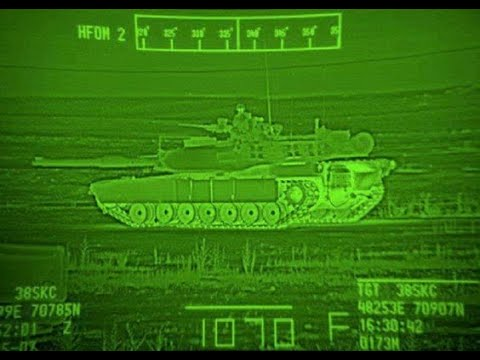
At a basic level, this is mitigated through tactics and manoeuvres to limit exposure to the enemy, such as maintaining hull-down positions and utilising terrain to screen and outmanoeuvre the opponent.
Technologically, active measures are taken to detect and mitigate a targeting action. Almost all contemporary AFV designs include warning systems, most notably laser warning receivers (LWR) which alarm to the crew in the event of a laser being projected onto the defending AFV. This laser is typically either a ranging laser being utilised by a weapon system to determine a fire solution or is a designator that is directing a missile or bomb onto the platform. Such an alarm allows the crew to take immediate defensive actions and can automatically deploys defensive measures to support the evasion.
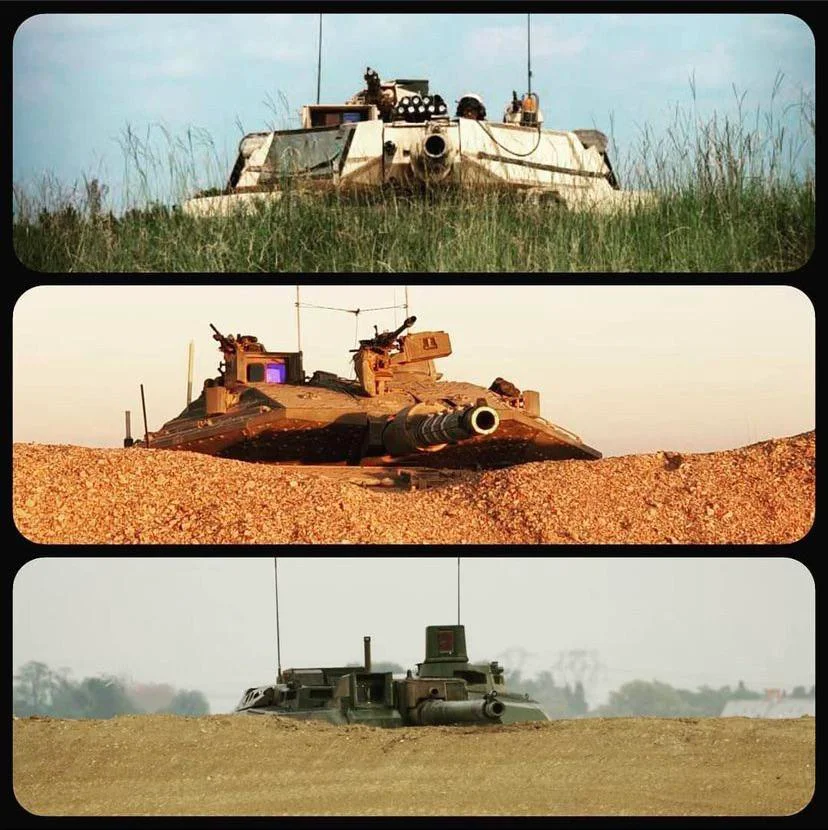
The most common defensive aid in this capacity is the projection of a multispectral smoke screen around the vehicle, usually limited to the frontal arc of 120° to 180°. Multispectral smoke, as the name suggests, provides for an obscurant aerosolised smoke screen in several spectrums, including visual and infrared, and is affected by the projection of grenades from launchers placed around the turret. These detonate in the air and form a near instantaneous screen in a hemispherical arc over the front of the vehicle. This provides a reasonably prolonged time for the vehicle to reposition without the enemy being able to observe the movement.
An option for the visible spectrum is to use exhaust smoke generators to lay screens, whereby diesel is injected into the hot exhaust to generate smoke, however these are slow to deploy and would not often readily serve to allow a response to an imminent engagement.
Further active countermeasures include laser, optical and radar jammers. These variously seek to disturb the seeker or command signal of an incoming missile or to dazzle or blind targeting systems observing the vehicle. Many of these defensive capabilities are now integrated into an automated system that selects and deploys countermeasures semi- or fully-automatically upon detection of a threat and are referred to as soft-kill active protection system (APS). Soft-kill refers to the defeat mechanism, which is ‘soft’ in that it seeks to interfere, blind or otherwise spoof the threat rather than kinetically destroy it.

Typically the APS initiates by sensing that it has a designator directed onto it, or other indicators such as optical detection of a missile launch or acoustic gunshot detectors, though the latter are limited to being comparatively slow and reactive by the inherent fact that most ballistic projectiles travelling faster than the speed of sound. APS that have additional hard-kill mechanisms may utilise radars to detect and track threats and allow initiation of soft kill countermeasure systems ahead of hard-kill effectors as part of a multi-layered protective response.
Don't be hit.
Assuming the vehicle has been seen and targeted, the next layer of protection is don’t be hit, which sees overlap with the precursor and successive layers as the defended vehicle attempts to avoid fire that is directed at it.
Cover and manoeuvre via mobility characteristics and capabilities are the basic tenets of avoiding enemy fire once targeted. The former provides for physical interference between the defended vehicle and the firer, preventing a threat from engaging with direct fire. Utilising the vehicle’s mobility to move into cover or otherwise move in such a way as to make an effective shot challenging or impossible is a further valuable capability.
Many of the systems that were used at the previous layer have the same utility at the don’t be hit level. Multispectral obscurants, decoys and countermeasures as well as jamming systems all assist in preventing an enemy from successfully prosecuting a target and hitting the defending vehicle.
Increasingly, hard-kill APS may be utilised to defeat an approaching threat. Hard-kill APS broadly seek to kinetically destroy, deflagrate or otherwise break up a threat projectile in flight prior to it reaching the defended platform - in slightly reductive terms they shoot down an approaching missile or rocket.

Such defeats are extremely violent, frequently utilising blast fragmentation mechanisms, and produce significant collateral effect even in a perfect engagement, so are generally reserved only for well armoured platforms. If successful, the host vehicle is not hit by the threat projectile as intended, though fragmentation and debris may impact the vehicle with some considerable velocity and remaining effect due to the fact it was flying straight at the vehicle a second or so earlier, before it was destroyed by the APS. A primer on APS is coming up on the blog soon™.
Don't be penetrated.
If the vehicle is hit, the next step is don’t be penetrated. This is perhaps the layer of the onion that comes to mind most immediately when you think of protection as a generic concept. It is the domain of armour itself and seeking to protect as the physical blow comes to bear.
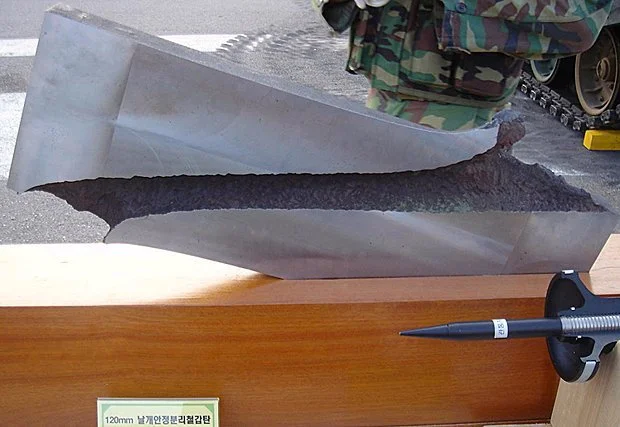
Armour is typically one of two major types – passive and reactive. Passive armour protects simply through its physical interference with the projectile. Whilst many contemporary AFV continue to utilise simple steel or aluminium as the ballistic protection, most combat oriented AFV now mount composite armour modules on top of the base metallic structure for significantly enhanced protection.
There may also be statistical armour ('bar' or 'cage' armour) mounted around the vehicle (typically on the sides and rear with heavier spaced or reactive armour on the frontal aspect), designed to defeat rocket propelled grenades. See the primer on statistical armour for more on that.

A further option is that of reactive armour. Most commonly encountered as Explosive Reactive Armour (ERA), but also as Non-Explosive Reactive Armour (NERA) and Non-energetic Reactive Armour (NxRA), the latter utilising alternative means to effect the same result as the more typical ERA. Reactive armour, as the name suggests, reacts when it is hit, most commonly by detonating a layer of explosive sandwiched between two metal plates, causing the plates to move and the explosive layer itself to be in a state of transition as the threat penetrates them.

This collectively creates an increased effective thickness of material to be penetrated, and a dynamic and thus disruptive material environment within which the threat is operating, which can disrupt it sufficiently to radically reduce its remaining energy as it passes into the main vehicle armour behind the ERA module. For more on ERA check out my twitter thread until such a time as I do a primer on the blog here.
Don't be killed.
The terminal layer of the onion is don’t be killed, and assumes all other layers have failed and the threat projectile has penetrated behind armour, this layer seeks to mitigate the damage that can be caused and prevent a kill. Note that in a protection context kill does not necessarily mean that the crew have been killed.
AFVs, like any platform, can be ‘killed’, that is rendered inoperable, in several ways. A kill can range from a catastrophic destruction of the vehicle (exemplified by all the T-72s brewing up in places like Syria and Ukraine) to mission or mobility kills, where significant systems within the vehicle have been damaged such that it can no longer carry out the functions required to operate.
At the most basic level, avoiding a kill is avoiding the crew and essential mission systems from being destroyed by behind armour effects. The first lines of defence in this regard are a spall liner and a fire suppression system.
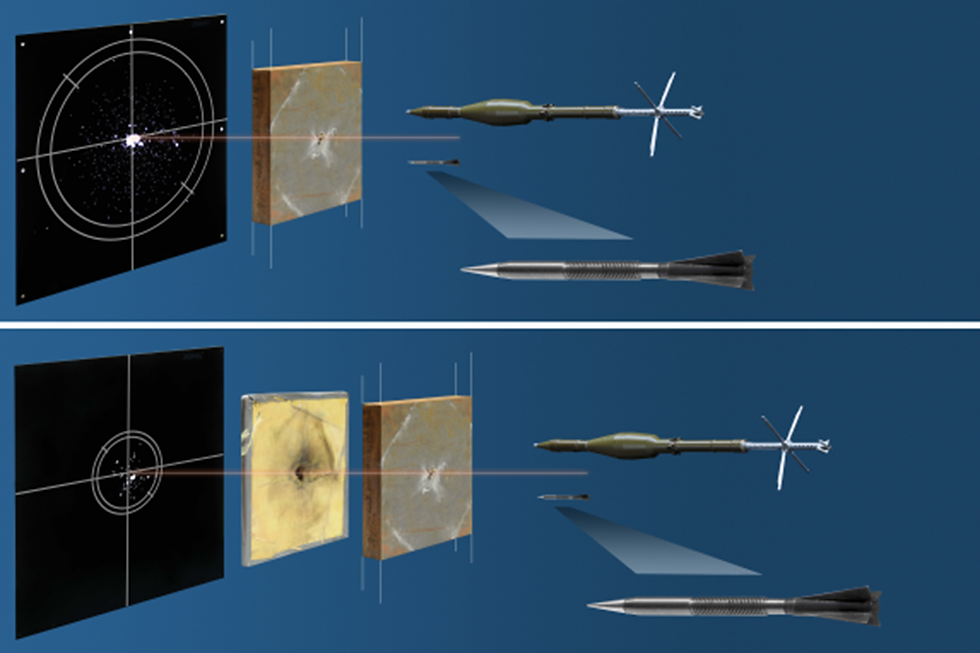
Spall liners are soft materials, typically an aramid or glass fibre, that are mounted against or in front of the metallic structure of the vehicle itself. Their purpose is to contain or at least mitigate spalling, which is where the interior surface of a metal structure breaks away as it is penetrated, projecting fragmentation inside the vehicle.

Spall liners serve to significantly narrow the danger cone around a penetrating threat's axis, meaning less people and things get hit, hopefully.

Beyond this, a fire suppression system is critical to limiting the dangers of a penetration. Typically triggered by UV/IR sensors in the crew compartment watching for the flash of a threat entering the compartment, the system very rapidly discharges a suppression agent into the compartment, typically less than 30 milliseconds from start of fire to start of agent release, and less that 90 milliseconds to extinguish the fire from its inception. It actually operates so fast as to be able to mitigate or halt the propagation of an explosion within the compartment too.
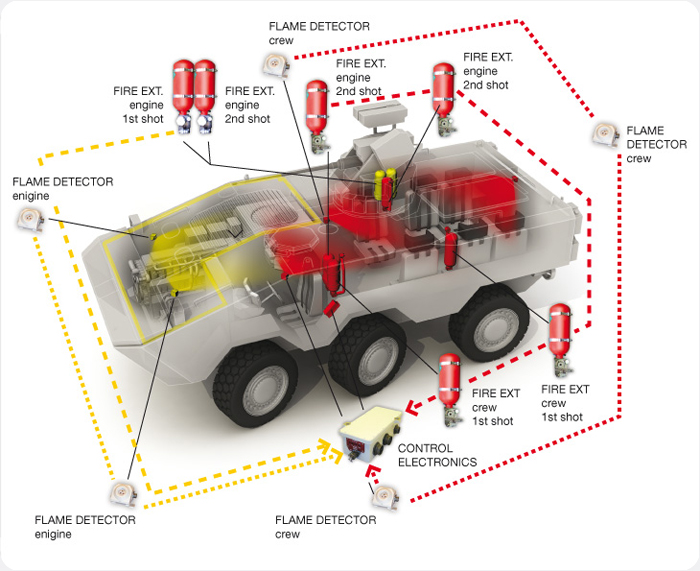
A lack of fire prevents obvious injuries to the crew, but also prevents subsequent damage and often spontaneous ignition of ammunition within the vehicle, which in an AFV can include large calibre high explosive munitions that can chain react and catastrophically destroy the vehicle. (Note: there'll be a primer of fire suppression systems soon)
This links to a further element of kill prevention – the inherent design and layout of the vehicle interior. Contemporary design standards expect ammunition and any other flammable and/or otherwise energetic materials to be stored in armoured containers with engineered weak zones that are designed to fail in a catastrophic ignition of the materials, directing any blast out, rather than into, the vehicle. Legacy vehicles, particularly those of Russian lineage, do not have this, and the results can readily be seen in videos of Russian T-series tanks being hit in the various conflicts in Ukraine, the Middle East and North Africa, where they rapidly explode or burn with extreme ferocity.

The same concept is now used in IFV and other medium weight designs, with ammunition magazines isolated from the crew and designed so as to direct an uncontrolled burn away from the crew compartments. Legacy vehicles see ammunition hand fed from open storage within the crew compartment into the weapon, presenting significant risk in the event of a compartment penetration.
Avoiding being killed by virtue of critically damaged systems is often mitigated via redundancy – systems that are essential to the continued function of the vehicle have two or more duplicate sets of hardware, and they are not collocated. Should one be destroyed, break down or fail, there are backups to take its place.

Owing to the rapid technological advances, unmanned turrets are increasing in usage, now fielded in a range of applications across global users. The use of an unmanned turret allows the crew and passengers to be fully isolated from the weapons and ammunition, meaning that survival in the event of a penetration into the turret is much higher. In the case of tanks, the Russian UralVagonZavod T-14 shows where this trend is going, with the crew of 3 sited side-by-side in the front of the vehicle where previously the commander and gunner would have been located inside the turret with the ammunition.
Why does it matter?
It matters because protection is so much more than lumps of armour. at the 'don't be penetrated' layer.
When people talk about survivability they have a strong tendency to do so solely in the blinkered view of "can the vehicle survive a hit". And the answer to that question will always be to add more armour of some kind. Look at any in-service AFV and you will see a significant weight and size increase over the vehicle's service life as users have chased greater protection by adding more and more armour.
For example, the British Army's Warrior IFV entered service in 1984 at a weight of 25.4 tonnes. In the Herrick theatre entry standard package that went to Afghanistan in 2007 the Army had added more than 15 tonnes of additional armour, equating to an additional weight of 59% of the original GVW.
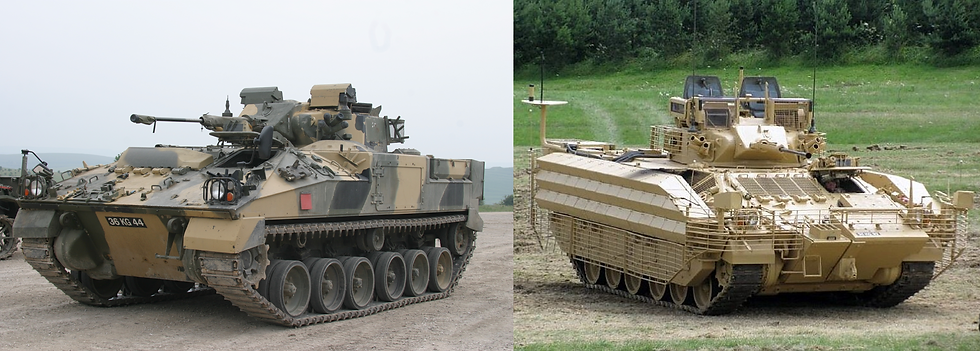
That 15 tonnes of extra armour brought with it a great deal of enhanced protection - bar armour for defeat of rocket propelled grenades, reactive armour arrays for defence against shaped charges and ATGM, electronic countermeasures and underbody armour plates for disrupting mines and IEDs. But all of these are adding protection purely at the innermost levels of the onion, once the threat has impacted the vehicle, and are siloed protection increases.
The oft-overlooked issue is - what has all this additional weight done to the power to weight ratio for the vehicle, to the ground pressure, the suspension performance, the reliability of the power pack and running gear, to vehicle handling dynamics or to noise and vibration levels? Power to weight, for example, has fallen from c.22 hp/t to as low as 13 hp/t for the Warrior over its life.
That means the vehicle has significantly reduced terrain access, meaning there are more areas of the battlefield where it would get stuck or be unable to get through than before. That makes it easier for an opponent to predict movements and shape the battlefield to constrain manoeuvre further. Working out where you could be, and finding a way to exploit that becomes much easier.
Looking back at the onion, if you are bigger, slower and heavier, you are easier to spot. You need to run engines harder to move the same way (or to move at all) and so you have greater audible and thermal signatures to aid in targeting you. You are in a holistic sense of protection more vulnerable, as you are easier to find and attack. Whilst you may well be more protected when you are hit, the risk of being hit is now greater, and therefore the risk that the enemy will more easily bring a weapon suitable for destroying you, in spite of your protection, is greater too.

That is not to say the armour on this Warrior example in particular is wrong, but it is to say that protection is a broad concept and simply increasing any one area may not mean a net increase in survivability overall, or at the least may mean you have traded one weakness (like being easy to penetrate with a particular weapon type) for another (like being easier to locate and ambush).
Organisations like dstl in the UK spend a lot of resources modelling and assessing the impact of proposed upgrades across the spectrum of protection, but that is not to say the Army doesn't just buy more armour anyway, or fail to prioritise and fund the associated mobility enhancements required to mitigate the costs of additional armour.
The key takeaway.
Protection is a broad concept that ranges from simply being seen to the more visceral concept of protection as a threat projectile hits your vehicle. Increasing one of these areas may increase protection in that aspect, but may well bring other weaknesses and does not necessarily increase protection as a whole. As with all things AFV, keep the big picture in mind and don't be drawn into a blinkered 'Top Trumps' mindset. And if in doubt, talk about onions.
Further Reading.
Links to protection primers on the site. I will add to this list as new topics are published.
Bar armour (statistical armour)
Protection topics in the pipeline for the blog soon™:
Active Protection Systems (APS)
Explosive Reactive Armour (ERA)
Fire Suppression Systems
Signature Management





It's also important to keep formation, unit and small unit tactics in mind.
A force that acts very quickly to generate and then exploit surprise will be shot at little, while a force that tasks tanks with open terrain overwatch from static positions will see them getting shot at much.
This is a large part of the explanation why merely bulletproof tanks overran France in 1940 in face of many thousands of 25 and 40 mm anti-tank guns and 75 mm light field guns, all of which were easily able to penetrate them at all relevant distances.
Some armies can get away with tanks that combine good firepower and mobility with lousy protection (Leopard 1), others won't.